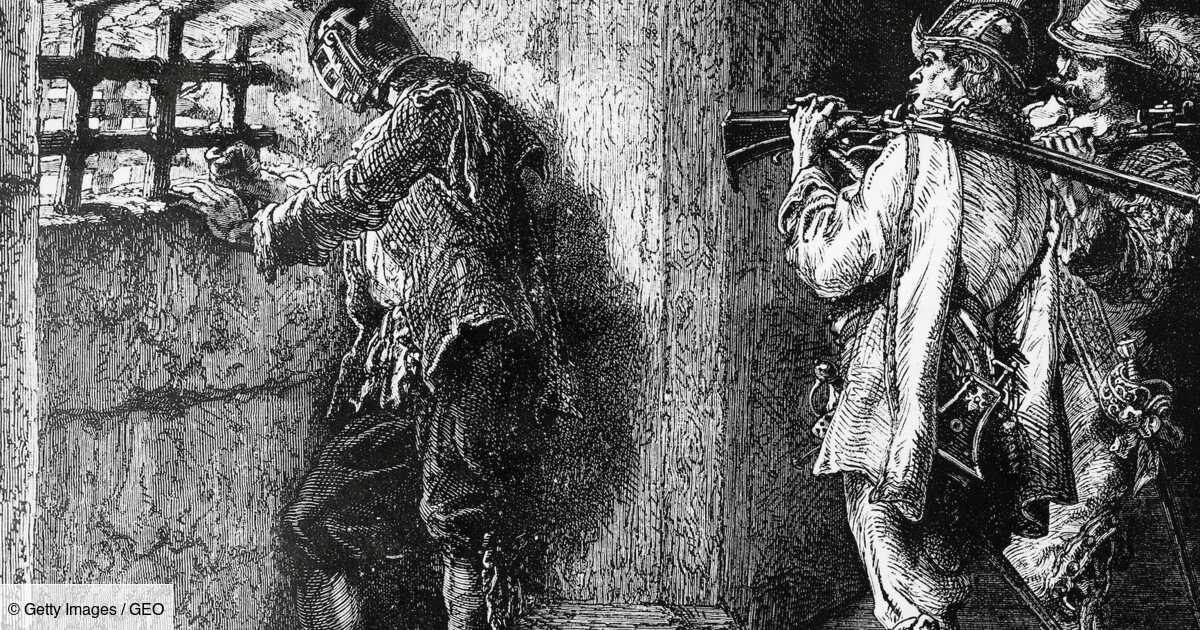After more than three centuries, mystery continues to surround the Man in the Iron Mask. Hidden twin brother of Louis XIV? Son of Cromwell? Queen’s lover? Moliere?
Since the death on November 19, 1703 of the famous embastillé, the hypotheses have not ceased to fuse. It was not until the 20th century that historians began to pierce the mists of this enigma. “We now know his name, his career in prison, his prison regime, lists the historian Jean-Christian Petitfils, author of Iron Mask, between History and Legend (Perrin, 2003). We even know why it was masked!”
One unknown remains: the exact cause of his arrest.
From Pignerol to the Bastille
“From the 18th century, the legend grew considerably, with many developments, says Jean-Christian Petitfils… when in reality it is a relatively banal story, that of a prisoner who knew a secret Politics.” No crowned head here, but a character of low extraction, a simple valet.
The latter was imprisoned in July 1669, by order of Minister Louvois, in the keep of Pignerol, a small French place in northern Italy, where another political prisoner, the former superintendent Nicolas Fouquet, was already imprisoned. He will know several successive jails, first at the fort of Exilles, between Turin and Briançon, then on the Sainte-Marguerite island where he is taken with great precautions. “He travels in a sedan chair covered with oilcloth, with two teams of eight Italian porters who follow one another to take him on the steep paths of the Alps, explains Jean-Christian Petitfils. At the Grasse stage, we saw him get out of his sedan chair: he was a tall man, his face covered with a steel mask. It is not an invention! This information can be read in a little gazette which circulated in Jansenist circles. Rumors are starting to spread throughout Provence… Who is he?”
Among the stories told about the mysterious prisoner, one of the most famous is that of the silver plate, reported by Voltaire in The Century of Louis XIV (reissue of 1752). The Iron Mask would have written his name on it before throwing it out of the prison window. It would have been discovered by an illiterate fisherman, who would have reported it to the governor. The latter would have verified that he had not been able to decipher what was written there, concluding by releasing him: “Come on, you are very happy not to know how to read!”
His jailer, Bénigne Dauvergne de Saint-Mars, passed from the government of Sainte-Marguerite to that of the Bastille in 1698, and the prisoner followed him. “This time, it was no longer in a sedan chair covered with oilcloth, says Jean-Christian Petitfils, with his face covered with a steel mask, because he had almost died of suffocation during the previous trip, but in a litter where he wears a black velvet mask.” He remained in the Bastille until his death in 1703, and is buried in the cemetery of the Saint-Paul church.
⋙ The Bastille, 400 years of history of the symbol of the French Revolution
Eustache Danger, the real name of the Iron Mask
“Since Voltaire drew attention to the character, novelists and pseudo-historians have had a field day, reports the historian. But the researchers found his trace in the archives, the ministerial correspondences and moreover, an act of prisoner of the Bastille which mentions the arrival of a masked man under the guard of Saint-Mars, and whose name was to be you.” His death certificate is registered at St. Paul’s Church as Marchioli, aged around 45 – highly unlikely, given that he spent 34 years in custody.
In reality, the Iron Mask is called Eustache Danger. In his letter to Saint-Mars of July 19, 1669, announcing his arrival in Pignerol, Louvois recommends taking extreme precautions to keep him… and never communicating with him, except to satisfy his vital needs. He also underlines his modest social condition, specifying that he is only a valet. Then, strangely, in 1674 the king agreed to Saint-Mars’ proposal to place Danger in the service of Fouquet.
“His condition is changing: from a simple prisoner, he becomes a valet-prisoner, and the terms of his detention become more flexible. But the king makes a specific requirement: under no circumstances will Danger have the right to communicate with Fouquet’s other valet, nor with the other political prisoner imprisoned at the same time, the Count of Lauzun. The same injunction to silence will follow the prisoner in his successive jails, until his death.
A diplomatic secret
It is therefore established that Eustache Danger knew a secret, of sufficient scope to make the monarchy tremble. But which one? Jean-Christian Petitfils thinks that this is a case linked to very secret diplomatic negotiations which were then tied between France and England through the intermediary of Henrietta of England, the sister-in-law of Louis XIV.
The latter was humiliated by the War of Devolution (1667-1668), a partially unsuccessful attempt to conquer the Spanish Netherlands, which he had to abandon under the joint threat of England, Sweden and the United Provinces ( current Netherlands). “He conceived an immense resentment, says the historian, and wanted to take revenge on the Dutch, whom he had helped to free themselves from the Spanish yoke. To this end, his interest was to declare war on Holland. But he first had to bring about a reversal of the alliance, which he prepared with Charles II of England, Henriette’s brother. At that time begins a encrypted correspondence, which has been called the “Great Secret”, which begins with a proposal from England: Charles II aims to restore Catholicism and absolutism, and he needs the support of Louis XIV for this.” Eustache Danger was therefore probably the valet of one of the intermediaries, perhaps of Henrietta of England herself, who became aware of these secret exchanges and was neutralized.
Why not just have it executed? “In the 17th century, people weren’t killed,” explains Jean-Christian Petitfils. In this very Christian monarchy, we do not commit murder, even for political reasons. To get rid of troublesome individuals who cannot be brought to trial properly, we prefer to send them to prison by lettres de cachet… and let them rot there.”
When the Iron Mask died in 1703, the Dutch War had been over for 25 years, and the importance of his secrecy had finally faded. “But you don’t release a state prisoner. It even often happens that we end up forgetting the reasons for their detention. We don’t know what to do with them, so we keep them. As for the famous iron mask worn during his transfer to Sainte-Marguerite Island, it was probably imposed by the proud jailer Saint-Mars, ultimately the true author of the legend, anxious to personally crown himself with glory and of mystery by using his most humble prisoner.
Read also:




